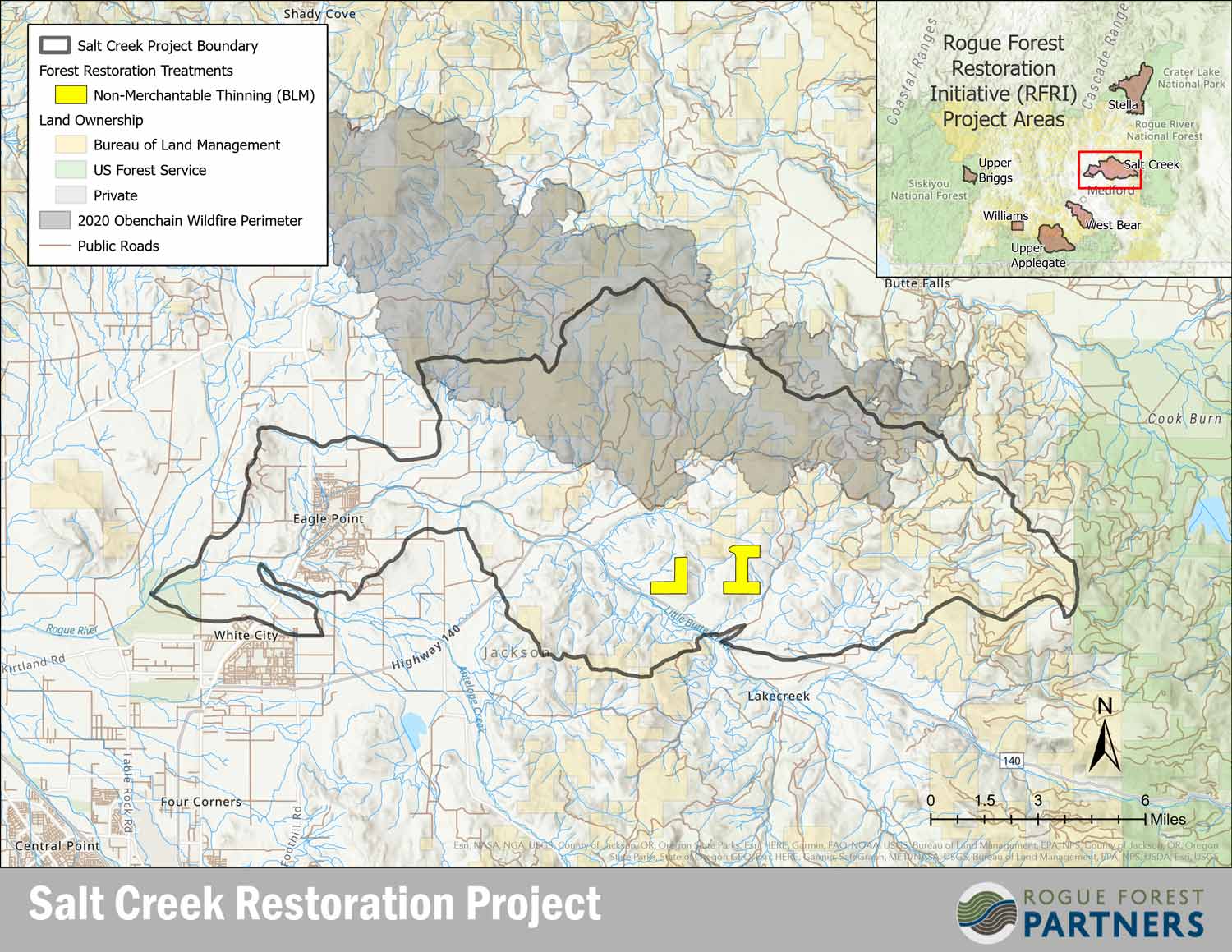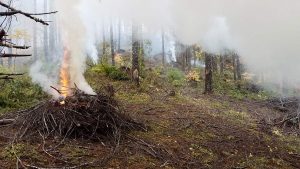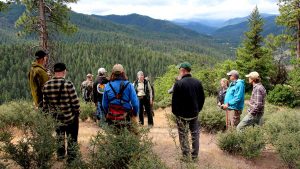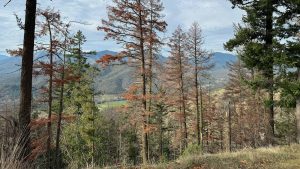Salt Creek Project Area
The Salt Creek project area lies within the Big Butte Watershed east of Eagle Point and northeast of Medford, Oregon. The project boundary includes federally managed and private lands identified for strategic application of ecological thinning, risk reduction treatments, and potentially underburning.
Planning for the Salt Creek Restoration Project prioritized BLM-managed lands that are difficult to access while working with adjacent private landowners. The strategic restoration work addresses legacy oak habitats and communities at risk of high-severity fire in rural landscape settings.
Where:
East of Eagle Point and northeast of Medford, Oregon
When:
Crews will begin restoration activity in the fall of 2023
Why:
Addresses legacy oak habitats and communities at risk of high-severity fire in our rural landscape
Scope:
710 planned acres to be treated (out of a 51,098 focus area)
Increasing the scale of restoration
Beginning in 2012, the Bureau of Land Management (BLM) conducted ecological restoration treatments with selective thinning and prescribed fire to 633 acres of BLM-managed lands. Through their alliance with the Rogue Forest Partners and supported by the objectives outlined in the Rogue Forest Restoration Initiative (RFRI), the updated forest management plan for Salt Creek will treat an additional 450 acres of BLM lands and 250 acres of private lands between 2023 and 2025.
Restoring nearby oak habitat
In 2022, the Klamath Siskiyou Oak Network (KSON), coordinated by our partners at Klamath Bird Observatory (KBO), received a large grant from the Oregon Watershed Enhancement Board’s Focused Investment Partnership.
Guided by the Klamath Siskiyou Oak Network Strategic Conservation Action Plan, the Little Butte Oak Initiative will reduce the two highest-ranked threats to oak-prairie habitat: wildfire and encroaching conifer trees. Stabilizing these habitats will also help to create resilience to climate change, insects, and disease.
Improving salmon and trout habitat
Since 2015, the Rogue River Watershed Council has worked with numerous private landowners along Salt Creek. Their efforts included replacing seven Oregon Department of Fish and Wildlife priority fish passage barriers with fish passage-friendly water diversion intakes, placing 269 pieces of large wood at 49 strategic locations, reconnecting 0.2 miles of secondary stream channel to the primary stream channel, and constructing 2.5 miles of livestock management fencing. These actions make 4.5 miles of salmon and trout habitat more accessible for migrating fishes and improve stream processes along two miles, ensuring sustained improvements to spawning and rearing conditions for native fish species.
During the stream restoration planning, the Watershed Council discovered additional opportunities for coordinating upland restoration. The need for different yet complementary treatments created an excellent opportunity for collaboration and an expanded project footprint.
RFP has identified six projects across the Rogue Basin. These high-priority areas, spanning public land and private tracts, are critically important for reducing the risks of extreme wildfires, promoting forest health, and restoring resilience to our landscape. The work began in the Applegate and Illinois Valleys in 2020 and continues into 2025.
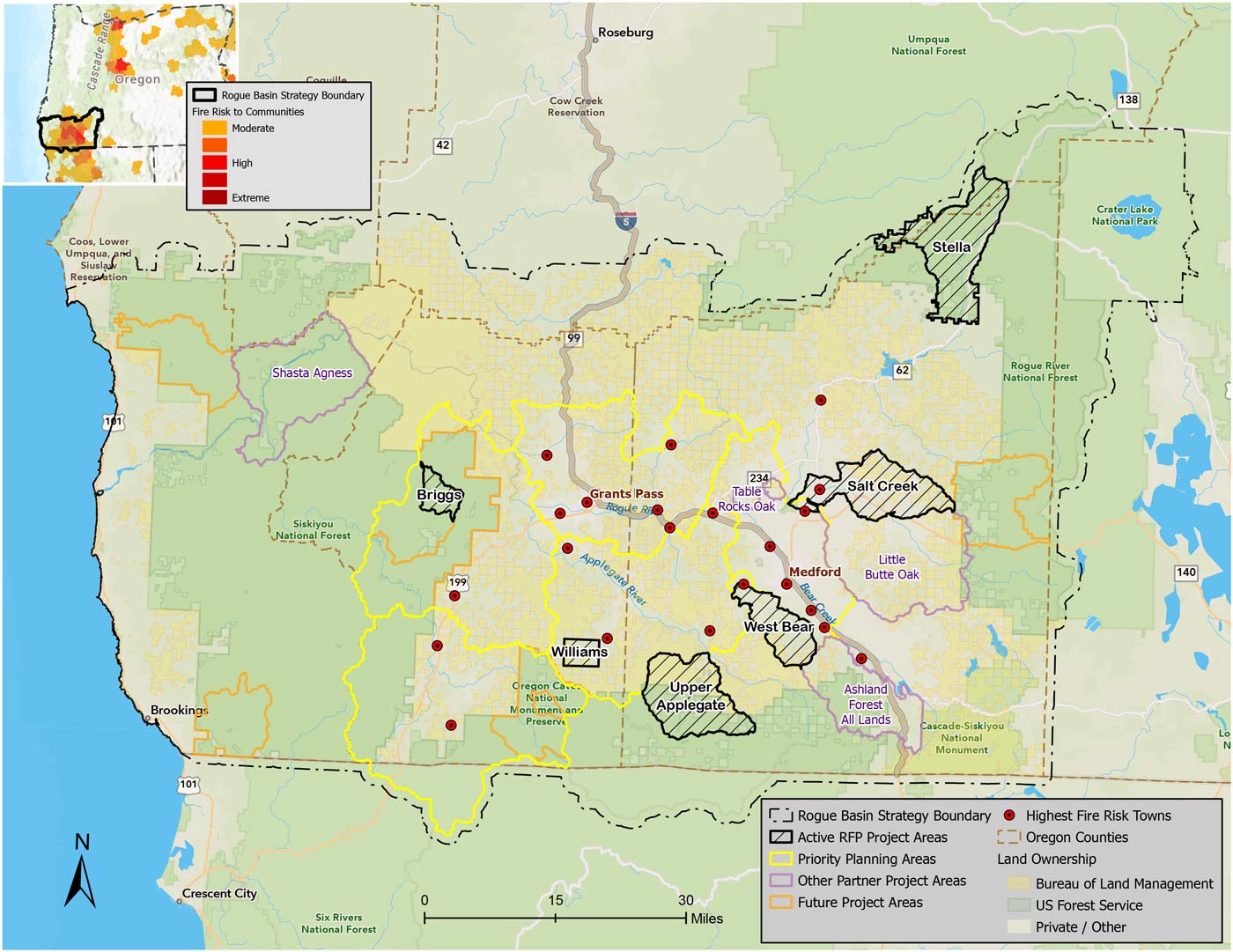
The Upper Briggs Restoration Project on the Wild Rivers District in the Illinois Valley supports diverse habitats and forest conditions. This ridge burned in the Klondike/Taylor fire, but from ridge to stream, one encounters legacy trees to protect, dense understories to be thinned and chaparral patches intermixed. The ridgeline is important for managing fires moving from wildlands toward Illinois Valley communities.
The Williams Project near the community of Williams in Josephine County is focused on reducing fuels and improving forest habitat through restoration treatments on federal and private lands in an all-lands effort bringing together the BLM and NRCS with the RFP to demonstrate restorative wildfire risk reduction. Together, we are working toward the landscape-vision of the RBS.
The West Bear Project addresses the need for wildfire fuels reduction immediately adjacent to the cities of Jacksonville, Phoenix, Talent, and Medford. The 27,000-acre project area within the wildland urban interface west of Bear Creek and the I-5 corridor is one of the most at-risk locations for wildfire in Oregon.
The 50,000-acre USFS and BLM Upper Applegate Watershed Project (UAW) is located in the Applegate Valley with over 18,000 acres of planned restoration treatments designed during a three-year community planning process convened by the Siskiyou Mountains Ranger District of the RRSNF. Some 3500 acres are scheduled by RFP to be completed by 2025. The UAW is one of the highest priority areas for restoration under the RBS.
The Stella Landscape Restoration Project project occurs in the most productive corner of the Rogue Basin, where the lack of low-intensity fire and past management has resulted in high-density stands and declining forest health. To improve wildlife habitat and forest health and build ecosystem resilience to wildfire, the Stella Project will strategically apply ecological thinning (both non-commercial and commercial) and prescribed fire to achieve restoration goals across a 43,955-acre footprint.
The Salt Creek Project planning area is large but RFP work with the BLM starts with a small footprint of fuels treatments in oak woodlands. The treatments will demonstrate ecological restoration under the RBS in these dry but diverse oak habitats and help reduce wildfire risks near the communities of Eagle Point.
The Rogue Basin communities, woodlands, and forests are at risk of uncharacteristic fire and no one organization can manage this risk. The Rogue Forest Partners share a common vision, seeking to restore forests and reduce risk by applying ecological restoration and bringing fire back as a tool.
Terry Fairbanks, Southern Oregon Forest Restoration Collaborative
News

